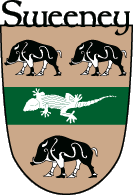|
 This data was
derived from the Leabhair Chlainne Suibhne (The Book of the Clan
Sweeney), which is a manuscript of personal prayers and a family history
now in the Royal Irish Academy. This data was
derived from the Leabhair Chlainne Suibhne (The Book of the Clan
Sweeney), which is a manuscript of personal prayers and a family history
now in the Royal Irish Academy.
The Sweeney's trace their ancestry from Niall of the Nine Hostages, the
fifth century High King of Ireland, through the eleventh century King of
Aileach in Donegal who was Flaherty of the Pilgroms Staff. Following a
family dispute over the succession of the Aileach kingship, Flaherty's
grandson, Anrathan, saiiled across the sea to Scotland. There, according
to a sixteenth century family history preserved in the Royal Irish
Academy, he acquired estensive lands in Argyll and married a daughter of
the King of Scotland. The Sweeney (Spelt Suibhne, pron. in Irish Swivnah)
from whom the family derives was a great-grandson of Anrathan who built
Castle Sween in Knapdale, reputedly the oldest stone Castle in Scotland.
Suibhne is undoubtedly an Irish name. In the fifth century there was a
high king of Ireland called Suibhne. There was a Suibhne Abbot of
Lismore, County Waterford, and another of Clonmacnoise, County Offaly. A
Saint Suibhne is recorded as dwelling on the penitential island of
Skellig Michael off the Kerry coast. These were the first names, there
are not necessarily any family relationships.
It was not until the coming of the Normans in the twelfth century that
Suibhne was adopted as a surname by a senior branch of the Ua Niall clan
of Scotland. There too the name Loughlin originated, which survives to
this day as a first name in the Sweeney family.
The Sweeney family remained in Scotland until the fourteenth century,
when they returned to Ireland having lost their lands in Argyll to
Robert the Bruce whom they had opposed at the battle of Bannickburn in
1314. After the Battle of Bannockburn there is no further mention of the
Sweeney family in Scottish History. The Sweeneys of Skipness had moved
to Northumberland, and the Sweeneys of Castle Sween had returned to
Ireland, where the senior branch returned to Rathmullan, almost in sight
of the ancient (c. 1700 BC) stone fort, the Grianon of Aileach, from
which they had departed for Scotland 200 years previously.
They then divided into three branches: MacSuibhne Fanad, MacSuibhne na
d'Tuatha, and MacSuibhne Banagh. Rathmullan was the seat of MacSuibhne
Fanad for the next 400 years, during which time their influence extended
from Donegal into Connacht and Munster. In Donegal their principal seats
were Doe Castle and Rahan Castle near Killybegs.
In Scotland the inauguration of the MacSuibhne chiefs had taken place at
Iona, whree they were also buried. In Ireland they were inaugruated in
Kilmacrenan, County Donegal, where MacSuibhne Fanad had the priviledge
of sitting at the right had side of the O'Donnell, Prince of Tirconnell.
The remains of the MacSweeneys who returned to Ireland are interred
outside the walls of Castle Doe, near Sheep Haven Bay.
|

|

